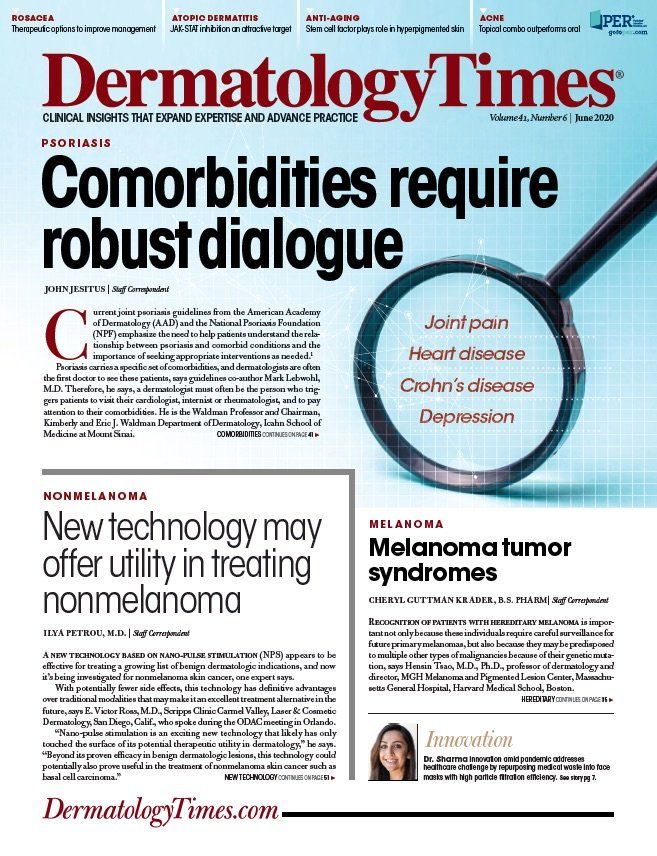- Case-Based Roundtable
- General Dermatology
- Eczema
- Chronic Hand Eczema
- Alopecia
- Aesthetics
- Vitiligo
- COVID-19
- Actinic Keratosis
- Precision Medicine and Biologics
- Rare Disease
- Wound Care
- Rosacea
- Psoriasis
- Psoriatic Arthritis
- Atopic Dermatitis
- Melasma
- NP and PA
- Skin Cancer
- Hidradenitis Suppurativa
- Drug Watch
- Pigmentary Disorders
- Acne
- Pediatric Dermatology
- Practice Management
- Prurigo Nodularis
- Buy-and-Bill
Publication
Article
Dermatology Times
Topical combination helps clear truncal acne
Author(s):
The topical combination of tretinoin 0.05% lotion and azelaic acid 15% foam improved truncal acne and may be an alternative to oral antibiotic treatment, according to recent case studies.

The topical combination of tretinoin 0.05% lotion (Altreno, OrthoDermatologics) and azelaic acid 15% foam improved truncal acne and may be an alternative to oral antibiotic treatment, according to case series of four acne patients published recently in Case Reports in Dermatological Medicine.1
READ MORE: Glycolic-salicylic acid serum safe, effective
About half of all facial acne patients have truncal acne. Dermatologists often treat truncal acne with oral antibiotics, sometimes due to anticipated challenges of applying a topical to a large body surface area. The problem is even in cases of severe inflammatory and nodular acne vulgaris, patients should take antibiotics only for the short-term. And antibiotics can lead to other issues, from microbial resistance to gastrointestinal microbiome disruption.
“In many cases of mild, moderate, or even severe truncal acne, combinations of topical therapies may be valid alternatives,” the authors wrote. “The introduction of foam formulations with enhanced percutaneous absorption and tretinoin lotion formulations that incorporate moisturizing/hydrating agents challenges the previously held idea that effective and tolerable treatment of truncal acne requires oral treatment.”
The authors reported outcomes from treating four female adult African-American truncal acne patients with a combination of tretinoin lotion 0.05% and azelaic acid foam. Each experienced sustained improvement of up to about three months using the topical combination. And each had tried other commonly used therapies, including antibiotics, with mixed results.
Patient one, a 30-year-old with a three-year history of severe back acne, was concerned not only about the acne but also the dark spots the lesions left behind. A dermatologist had prescribed oral erythromycin, which improved but didn’t clear her skin. The previous dermatologist then switched to oral doxycycline and adjuvant daily adapalene lotion 0.1%, which didn’t help.
The author prescribed tretinoin lotion 0.05% for its favorable particle size, homogenous distribution and formulation. Tretinoin lotion 0.05% has added hyaluronic acid and collagen, which might decrease dryness and irritation, according to the paper. Azelaic acid foam, which the author prescribed twice daily, is known to have a lightening effect on skin.
At four weeks, the patient said she was satisfied with treatment and her dark spots appeared lighter. At 12 weeks, the author reported no evidence of acne and sustained post-inflammatory hyperpigmentation improvement.
RELATED: Trifarotene cream proves safe, effective for acne vulgaris
Patient two, a 33-year-old with a long history of acne, seborrheic dermatitis and mild atopic dermatitis, tried many over-the-counter and prescription acne medications. Among the regimens she had tried for truncal acne: once daily oral doxycycline 150 mg and azelaic acid foam 15% twice daily. The patient said this and other regimens helped but didn’t clear her skin or the hyperpigmentation on her chest, shoulders and back.
Another regimen, which controlled her truncal acne for more than six months until the acne recurred, included benzefoam 9.8% topical foaming short contact cleanser for her face and chest, azelaic acid 15% foam for her chest, hydroquinone 4% lotion for the hyperpigmentation on her chest and back, as well as some facial treatment options. Three months into that regimen, she stopped taking oral antibiotics and beganapplying adapalene 0.1% lotion on the chest and back once daily.
The patient became frustrated with the hyperpigmentation on her chest, shoulders and back. Even a series of five chemical peels consisting of 20% salicylic acid effectively lightened the pigment and controlled the acne only initially.
Combination therapy with tretinoin lotion 0.05% twice daily and azelaic acid 15% foam controlled the truncal acne and post-inflammatory hyperpigmentation at four and eight weeks.
Patient three, a 24-year-old with long-term facial acne, complained of a recent severe flare of her acne on her neck, jawline and chest. Her neck had scarring, acne cysts, erythematous macules and hyperpigmented macules. Her chest had erythematous papules and macules and her back and shoulders had numerous erythematous papules and hyperpigmented macules, the authors wrote. The patient applied the tretinoin 0.05% lotion nightly to the chest, neck, shoulders and back and azelaic acid 15% foam twice daily to the chest, shoulders and back. The regimen also included medications to address the facial acne. At one month, her face, chest and neck were clear.
Patient four, a 32-year old with long-term facial acne, noticed truncal acne eruptions on her chest and back after she started working out.
READ MORE: Menlo and Cutia enter agreement for topical minocycline products
The treatment initially was to shower right after workouts and apply topical benzefoam 9.8% to the chest and back, but the ares continued during the next three months. She tried minocycline 115 mg orally daily and adapalene 0.1% lotion on her back once daily. That regimen controlled the ares at two months, leaving hyperpigmentation on her back, shoulders and chest. The provider switched her from minocycline to oral doxycycline. At four months, her truncal acne flared and continued to are in the next year. She also developed atopic dermatitis.
The patient admitted that she wasn’t taking the oral medications as prescribed and preferred topicals. Her truncal acne treatment then changed to tretinoin lotion 0.05% once daily at bedtime and azelaic acid 15% foam twice daily. She was satisfied with the treatment and said her breakouts were less frequent at her one-, two- and three-month follow-up visits.
The authors acknowledge the study’s relatively short follow-up is a limitation, especially considering that adult female acne often is more chronic and relapses more frequently than adolescent acne.
Disclosures:
Ortho Dermatologics supported the study. The authors declared no conflicts of interest on the topic.
References:
1. St Surin-Lord S, Miller J. Topical Treatment of Truncal Acne with Tretinoin Lotion 0.05% and Azelaic Acid Foam. Case Rep Dermatol Med. 2020;2020:5217567. Published 2020 Mar 16.






